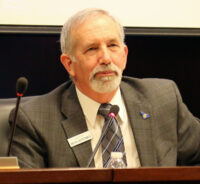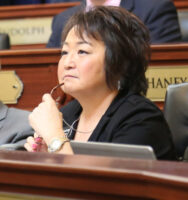The leaders of the Legislature’s education committees on Friday issued a unified call to continue funding raises for Idaho teachers.

House Education Committee Chairwoman Julie VanOrden and Senate Education Committee Chairman Dean Mortimer both briefed members of the Joint Finance-Appropriations Committee about their budget priorities.
Friday’s briefing offered the education leaders a final chance to drum up support for programs and policy initiatives before JFAC sets the public school budget on Feb. 27.
“Continuation of the career ladder is the No. 1 priority of the Senate Education Committee,” said Mortimer, R-Idaho Falls.
VanOrden, a Republican from Pingree, agreed, saying it was important for lawmakers to make good on a promise they made in 2015 to ramp up teacher salaries by an estimated $250 million over a five-year period. The raises are designed to improve the recruitment and retention of teachers and to provide educators with a living wage, VanOrden argued.
Both Superintendent of Public Instruction Sherri Ybarra and Gov. Butch Otter requested the Legislature invest $58 million in increasing teacher salaries next year — a figure that is estimated to grow to $62 million to cover enrollment growth at schools across the state.

That $62 million figure would also represent the most expensive installment of teacher raises under the career ladder plan.
From there, the education leaders also called on budget writers to financially support school districts as they absorb rising health care costs. However, VanOrden and Mortimer will leave the specifics of addressing health care costs up to JFAC.
Members of the education committees hold differing views on how to pay for health care. Some legislators favor Otter’s plan to set aside $15 million in a separate, new fund dedicated to health insurance costs. Others pushed for giving local schools as much latitude as possible by increasing discretionary pay for districts — as Ybarra called for.
Overall, Mortimer and VanOrden said the recommendations Otter’s Task Force for Improving Education issued in 2013 continue to serve as the blueprint for education policy and budget decisions.
“In summary, the initiatives from the Governor’s Task Force for Improving Education are being placed into action, and the results are proving to be positive,” Mortimer said.
Both Otter and Ybarra called for increasing education spending by more than $100 million next year. Each year, public school spending is the state’s largest expense, and is likely to account for about 48 percent of all general fund spending once all the budgets are finalized.
Schools as polling places?
Idaho has a polling place problem, says Phil McGrane, Ada County’s chief deputy clerk.
Schools remain the state’s polling place of choice — schools comprise half of Ada County’s polling places. But there’s a growing push to move voting out of schools, in order to ensure student safety.
As a result, elections clerks are looking for new voting venues. One county has been forced to set up polling stations at a frozen yogurt restaurant.
“When I think of election day, I don’t think of going into a frozen yogurt shop,” McGrane told the House State Affairs Committee Friday morning.
McGrane’s solution: a bill that would close schools on election days. Schools could use election day for teacher training or in-service days.
Lawmakers were skeptical. Some wrestled with the mandatory language, requiring schools to close. Some said the change would place a burden on parents, who would have to find child-care options on election day. One lawmaker questioned the risk — particularly on days when the schools and parking lots are crowded with voters.
“If I was a terrorist, I think I’d choose another day,” said Rep. Randy Armstrong, R-Inkom.
A motion to kill the bill died on a 7-6 vote. Then House State Affairs voted to introduce McGrane’s bill. That initial step sets the stage for a full hearing at a later date.
Student assessments
House Education approved a bill to allow teachers to use “multiple measures” to gauge student skills for kindergarten through 12th-grade students.
The idea is to move away from the use of a single assessment to measure skills in reading.
House Bill 105 is an offshoot from the Legislature’s 2016 “literacy initiative,” designed to provide extra help for at-risk readers. Each fall, about 36,000 K-3 students enter school without grade-level reading skills.
HB 105 heads to the House floor, with the committee’s unanimous support.
(Click here to link to an in-depth Idaho Education News-Idaho Public Television series on the literacy initiative.)
Congratulations, Alaska and Hawaii …
In 1953, Idaho joined the Western Interstate Commission for Higher Education — joining a compact of other states.
Alaska and Hawaii signed on at the time, when both were territories. That all changed — in 1959. But the 1953 WICHE compact still lists Alaska and Hawaii as territories, not states.
House Bill 105 clarifies the fact that Alaska and Hawaii are indeed states. House Education gave HB 105 its unanimous backing. It now heads to the House floor.
Idaho Education News reporter Kevin Richert contributed to this report.
